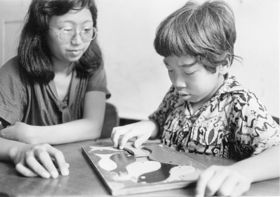Hesperian Health Guides
Toys Children Can Make
HealthWiki > Disabled Village Children > Chapter 49: A Children’s Workshop for Making Toys > Toys Children Can Make
| There is an old saying ... "THEY WHO CHOP THEIR OWN FIREWOOD WARM THEMSELVES TWICE!" |
We have a new saying... "THE FAMILY THAT MAKES ITS OWN TOYS HAS TWICE AS MUCH FUN!" |
 |
 stuffing a homemade doll with wild kapok |
 | |
| Helping to make toys for other children can be just as educational—and fun—as playing with them. | |
Many of the most fun, most educational toys can be made from scrap materials by members of the family or community. Children with disabilities who can use their hands can learn skills and take pride in making toys for others. So it makes sense to make toys rather than to buy them.
Below are a number of toys that children can make in a children’s workshop. Or children with disabilities or their families can make them at home. We start with very simple toys for babies or children at an early developmental level. Gradually, the toys become more advanced. More skills will be needed by the children who make them, and by those who play with them.
Contents
TOYS TO ENCOURAGE LOOKING AND LISTENING
| small mirrors or pieces of tin foil or shiny paper | colorful objects that move in the air |
 small bells
from UPKARAN manual. | |
Toys that help develop use of hands and sense of touch
You can make beads and chains out of wild fruits and nuts.
| prickly | rough and smooth |
fuzzy | wrinkled or lumpy |
smooth | wriggly |
 |
 |
 |
 |
 |
 |
| For a baby, hang a ring of beads where she can reach and handle it. | A child can play putting the nuts and pods in and out of a container. | As the child develops more hand control, she can begin to make chains and necklaces by stringing beads on a cord. |  | |
 |
 Later he can learn to sort them — first by seeing them, and then blindfolded. | |||
| “Snakes” can be made by stringing nuts, “caps” of acorns, bottle caps, or any combination of things. |
 small green mango
(or whatever you can think of) bottle caps
beans for “rattle” of rattlesnake |

from papache bush
from wild bush)
If you use your imagination, there are all kinds of toy animals you and your children can have fun making.
Rattles and other “noise toys”
 Gourd rattle
Find a small gourd (wild gourds or tree gourds may work). |
 Cut a round hole at the stem and clean out the seeds and flesh. Let it dry out well. |
 Put 2 or 3 small rocks, nuts or other objects inside. |
 Find a stick the size of the hole. If the hole is large, thin down this part of the stick. |
 Glue the stick
to the gourd. Glue here.
To make it stronger and better looking, mix white glue and sawdust, fill in here, and after the glue dries, sand it smooth. |  Paint it colorfully. |
Plastic bottle rattle |
Bamboo rattle |
Tin can rattle | |
 a see-through
plastic bottle stick of wood
strips cut from plastic
bottles of different colors, colorful stones, nuts, etc. ring cut from a plastic
bottle, bamboo or whatever you have ring can be wrapped with strips of cloth or tire tubing for easier grip |
 SIMPLE FORM
cork or
plug WITH HANDLE |
 |
|
Cowhorn rattle
| Trim rough edges. |  |
Put in a cardboard or wood plug. |  small rocks |
Then seal with a mix of sawdust and white glue, or plaster of Paris. |  glue
sawdust
Smooth the
surface and let it dry. |

Ideas for homemade music
(from How to Raise a Blind Child)
 |
 |
 can lids |
 |
 can lids | |
| gourds with seeds in them |
2 wood sticks | tambourine | jingle bells | jingle bells | |
 marimba
loose hardwood plates |
 castanets (wooden clappers) | ||||
Soft rattle
Use a small can or bottle with a small stone inside... |
...or use 2 small bells.  |
Cut a colorful soft cloth (flannel) into this shape.  |
Sew it into a square and turn inside out. |
Place can or bells in cloth square and pack wild kapok, cotton or bits of sponge around it. Sew it shut. |
 wild kapok |
Doll rattle
| Draw a doll on 2 pieces of cloth, and cut them out. |
 |
Sew the 2 dolls together. |  Leave a small opening.
|
Turn the doll inside out.
 |
Put small bells or a rattle inside and stuff with kapok, cotton or sponge and sew shut. |
Sew or draw on a face.
 |
Animal rattles |
Ball rattle | |||
| can be made in the same way. |
Cut 3 pieces of one color... |
...and 3 pieces of another color. |
Sew them together except for a small hole. Turn inside out and stuff. | |
 |
 |
 |
 |
 |
Push-along noise toy |
Bamboo push-along |
|
 Make hole in lid and
bottom of tin. Put bottle tops,
small stones, etc. inside. Put loop of stiff wire through holes with knot inside tin. |
 |
 Cut here
|
Plastic bottle pig
| 1 plastic bottle | 4 corn cobs | cardboard or leather for ears (Make 2 cuts in the bottle to hold ears.) | |
| Make 4 large holes and one small hole. |  |
 |
 |
| beans, rocks, nuts or bottle caps to put inside if you want it to rattle |  |
hard curved acacia bean(or anything else for tail) |  |
Papier-mâché piggybank | ||
 Cover a balloon with papier-mâché.
|
 strips of newspaper or packing paper paste of flour and water 4 to 6 layers thick |
 Cut 6 lumps off a cardboard egg carton. 4 like this 2 like this |
 Fasten down lumps with papier-mâché. |
 Corks can be used instead of egg cartons. |
 With a few coins inside, the pig can be used as a rattle. Decorate with paint. |
Papier-mâché frog | ||||
 balloon |
 4 pieces of thick cardboard |
 cardboard tube (perhaps from old toilet roll)
cut tube |
 Cover with papier-mâché and attach “feet” and “hands.” |
 When dry, cut out mouth and paint. |

Note: For the pig and frog, you can use a large gourd instead of a balloon.
Games fitting pegs or blocks into holes
These games help develop better hand control and hand-eye coordination. They also help the child learn to compare sizes, shapes, and color.


with sand (and lime if you
have it). Press pegs into
the wet plaster, and
remove when
almost dry.





Other ideas
Blocks for building a tower on pegs |
Animal stackers |
 Make it
more fun by putting a face on the top block. Blocks can
be cut from a thin log. Paint them bright colors. |
 tail made of broom, stick or rope
Cut rings from a thin log or bamboo.
leather or cloth ears
pegs
stick to fit
rings over hole to fit tail into |
Slide-on wire toys
To help develop fine control of hand movement, blocks, beads or animal figures can be moved along a wire. Children with poor control need only move the figure from one side to the other. Children with good control try to move the figure without touching the wire. The more bends you put in the wire, the harder it is.
 |
To make it more interesting, match the animal figures with wooden bases in the form and colors of the place the animal lives: fish in water, squirrels in trees, birds in flowers. |  |
 |
Gourd Racing Car |
 beans as
decoration pull string |
Gourd baby |
||
| The gourd baby is fun because it can be given drinks and then “go to the latrine.” Thus it can be a good tool for toilet training children. See other ideas and dolls for toilet training. |  plug
plug
|
 Now go poo poo in the potty.
Good boy! |
Shapes on pegs*
|
Figures with posts for easy gripping*
|
 With these, children learn about matching colors, shapes, and sizes. |
 |
Building blocks | |
 made of wood, clay, or layers of cardboard. |
 cubes and sticks |
These are from the UPKARAN Manual.

Biting donkey
This wooden donkey or horse with a clothes-pin head is fun to make and to play with.
It can also be used as a note or reminder holder. Perhaps children with disabilities at the rehabilitation center can make this to sell for pocket money.
Trace the donkey onto a piece of wood about as thick as the clothes-pin (1 cm). Cut it out with a jig saw. Also make a base, as shown. Sand pieces smooth and glue together.
Donkey carts
 wheels
bamboo |
 |
 old plastic bottle |
 |
| Tie or glue cart together. |
Climbing bear
Cut a pattern of the bear out of a wood board about 2 cm (¾ inch) thick.

Hang a stick from the roof or a tree limb.

By pulling one cord and then the other, the bear will climb the ropes! Children love it!
Good for developing use of both hands together.
RUBBER BAND WIND-UP TOYS
Steamroller |
HOW WIND-UP POWER DRIVE WORKS | ||
| bamboo (or cardboard tube or corncob) |  | Cut loop diagonally for more length. |  |
 | |||
| To help roller pull better (not slip), cover it with rubber tire tube or sandpaper. | old bicycle tire tube | Instead of a rubber band, you can cut a narrow loop of inner tube. | |
Paddle wheel boat
 Paddles from tongue depressors or pieces from an old plastic bucket, etc.
Notch the paddles and put them together like this. |
 rubber band
Use it to help the child enjoy bathing, develop hand control and even speech. |
Corncob creeper
 | ||
| Use an old spool or corncob. | ||
 Notch rim of spool to help it pull without slipping. |
 two small nails to hold rubber band
hole |
 piece of soap
rubber
band Wind up the completed toy and watch it crawl! |

For more fun, place a paper cone over the creeper, and decorate it to look like a person or animal.
Whirlygig screech plane
This simple noise toy can be made completely of waste material. The pin mounted at the front scrapes against the inside of the bottlecap—and the cups amplify the noise like the loud-speakers of a record player.
 thin cardboard, folded and twisted, glued to stick
thin stick 2 plastic cups glued together plastic cup melted with hot wire to hold pin tight pin
bottlecap
cardboard or thin foam plastic scraps glued to the cups |
 It whirls! It squeals! It flutters! |
PUZZLES
Puzzles can help a child learn how shapes, forms, and colors fit together. Puzzles can be made by glueing a picture on cardboard, wood, plywood, or other material. Cut out the pieces with a coping saw. Puzzles can be made in various styles:
Flower puzzles |
Figure puzzles |
 Children can first learn to form one flower.
Later, they can play “sorting games” with flowers of different colors.
Several children can play to see who can complete a flower first—using dice with different colored sides. |
 |
Puzzles with cut-out pieces that follow the forms and lines of the drawing
| First have the child build the main object (here, the owl) with a few pieces. Later, she can learn to fill in the background. |  |
 | |
| An outer frame helps hold the pieces together. | A child with cognitive delay in Indonesia learns to fit together a fish puzzle. (Photo: Christian Children’s Fund, Carolyn Watson) |
| Puzzles with interlocking pieces | Block puzzles |
 |
 |
| Suggestion: If you have a large photo of the child or a family member, glue it on cardboard and cut out the puzzle. Or use a picture from a magazine or calendar. | Glue 6 different pictures to the sides of a thick board or sheet of foam plastic, and cut it into blocks. You can also make blocks from cubes of clay or small match boxes. |
Ideas for the toys shown in this chapter are from many sources, including books.
For books on toys and games, see Other Resources. Other toys are in sections:
Helping the Blind Child to Use His Hands and to Learn Skills
Early Play Activities and Toys
Ways to Make Toilet Training Easier
Bathing
Range-of-Motion and Strengthening Exercises for the Hand and Wrist.


